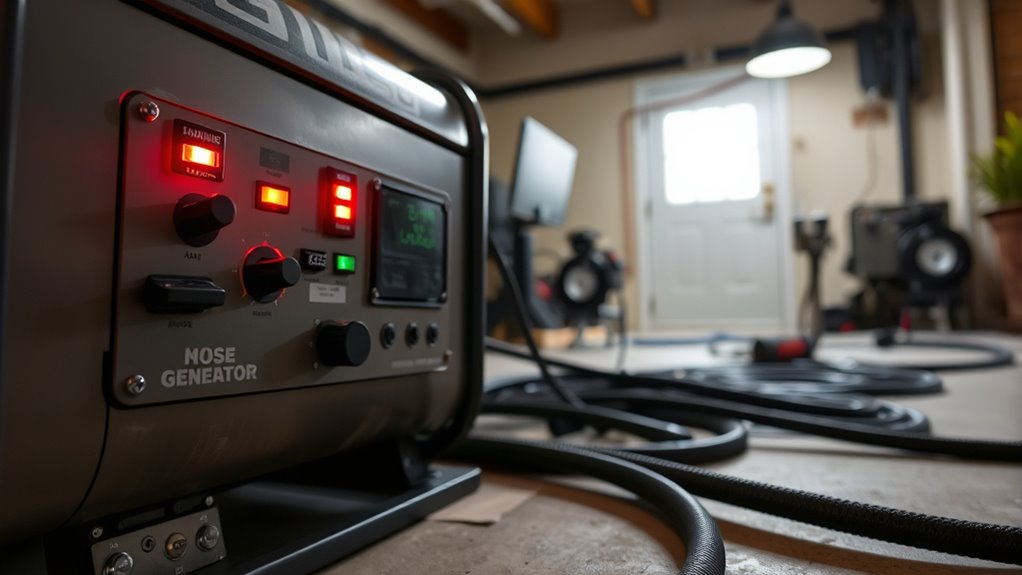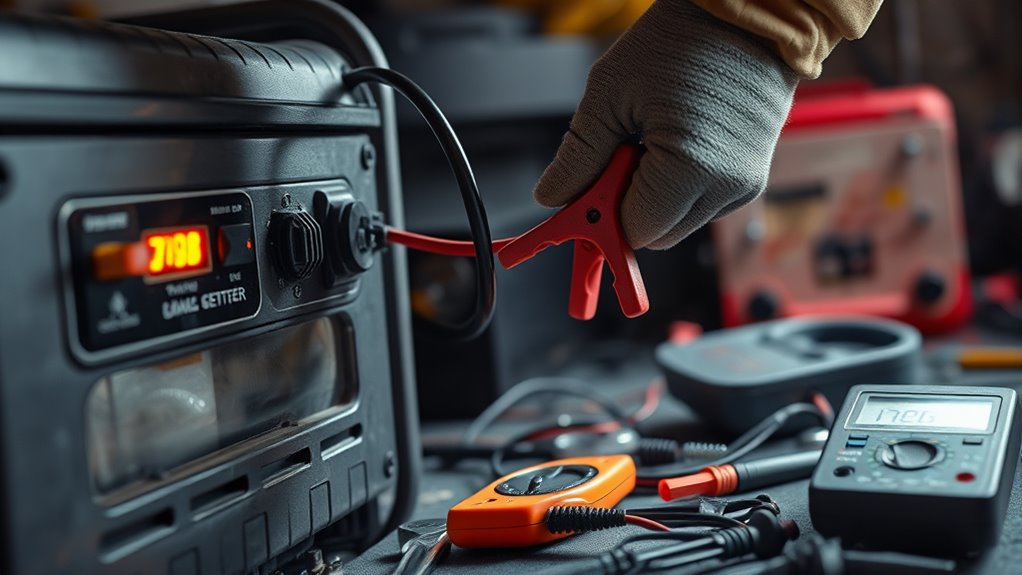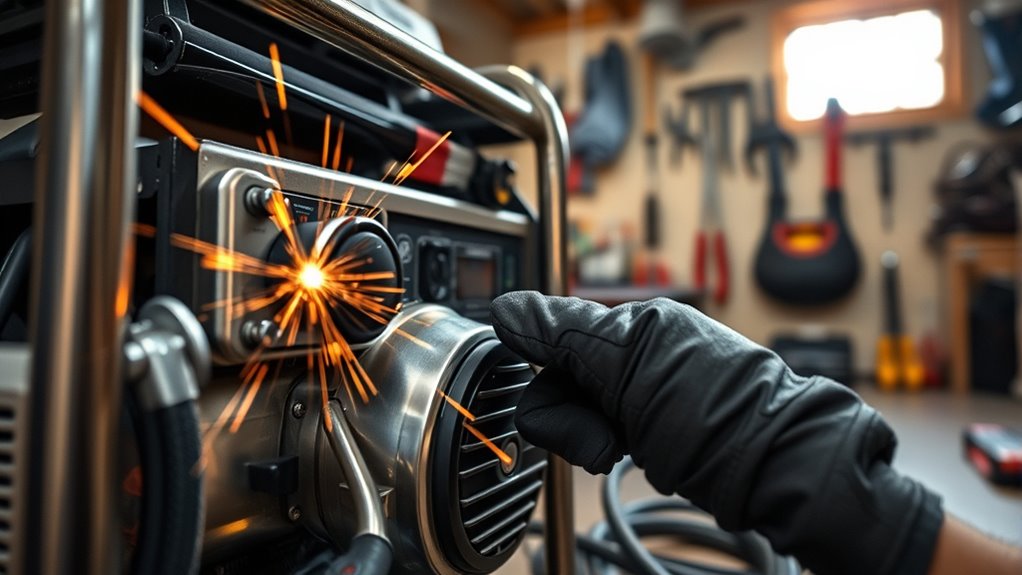To start and maintain your generator during long blackouts, regularly inspect and service it beforehand—check oil, fuel, filters, and battery. When needed, start it on a flat, ventilated surface, ensuring all connections are secure, and warm it up before connecting appliances. Monitor fuel levels, engine temperature, and load during operation to prevent overloads. Consistent maintenance and troubleshooting keep your generator reliable—continue exploring for detailed steps to ensure you’re fully prepared.
Key Takeaways
- Perform thorough pre-start inspections, including oil, fuel, air filter, and battery checks, to ensure reliable operation during long blackouts.
- Follow safety protocols for starting, such as proper placement, fuel handling, and testing the spark before initial operation.
- Monitor fuel levels, engine temperature, and load capacity regularly to prevent overloads and maintain steady power output.
- Conduct routine maintenance like oil changes, filter replacements, and cleaning of cooling fins to sustain generator performance over extended use.
- Store the generator properly with stabilized fuel, clean components, and periodic checks to ensure readiness for prolonged blackout situations.
Preparing Your Generator Before the Power Goes Out

To guarantee your generator is ready when the power goes out, you should start by performing regular maintenance checks. Inspect the oil level and change it if necessary, since clean oil ensures smooth operation. Check the fuel tank and fill it with fresh fuel, avoiding old or contaminated fuel that can cause starting issues. Examine the air filter and clean or replace it if it’s dirty; a clean filter improves engine performance. Test the spark plug for wear or damage, replacing it if needed. Also, inspect the battery (if applicable) and ensure all connections are secure. Regularly reviewing Gold IRA rollovers can help inform your investment decisions, even during power outages. By staying on top of these maintenance tasks, you minimize the risk of surprises during an outage and keep your generator reliable when you need it most.
Starting Your Generator Safely and Properly

Before starting your generator, make sure it’s placed on a flat, well-ventilated surface away from windows and doors to prevent carbon monoxide buildup. Check that all fuel valves are closed, then fill the tank with fresh fuel, avoiding spills. Turn off all appliances connected to the generator. Set the choke to the “start” or “closed” position if your model has one. Turn on the fuel valve, then set the ignition switch to “on.” Use the recoil starter or electric start to crank the engine. Once it fires up, gradually open the choke if it stalls. Allow the generator a few minutes to warm up before connecting devices. Always wear protective gear, and keep a fire extinguisher nearby for safety. Monitoring your generator’s maintenance requirements ensures reliable operation during long blackouts.
Monitoring and Running Your Generator During an Outage

Monitoring your generator during an outage is essential to guarantee it runs safely and efficiently. You should keep an eye on fuel levels, engine temperature, and oil pressure to prevent damage. Listen for unusual sounds, and watch for warning lights or alarms. Regularly check for leaks or blockages that could hinder performance. Ensure the generator is grounded properly and avoid overloading it by connecting only necessary appliances. Use the following table as a quick reference:
| Monitoring Area | Key Indicators | Action Needed |
|---|---|---|
| Fuel | Fuel level, refuel as needed | Refill before it runs out |
| Engine Temperature | Normal operating range | Turn off if overheating |
| Oil Pressure | Consistent pressure, no leaks | Add oil or inspect for leaks |
| Noise & Alarms | Unusual sounds or warnings | Shut down and troubleshoot |
| Load Management | Avoid overload, disconnect excess | Reduce load to safe levels |
Additionally, regularly inspecting the generator’s maintenance schedule can help prevent unexpected failures during outages.
Regular Maintenance and Inspection Checks

Regular maintenance and inspection checks are essential to keep your generator ready for long blackouts. You should follow a consistent maintenance schedule, perform visual inspections, and check oil and filters regularly. Staying on top of these tasks helps prevent breakdowns and guarantees reliable operation when you need it most.
Scheduled Maintenance Schedule
To guarantee your generator remains reliable during long blackouts, establishing a strict maintenance schedule is essential. Regularly plan inspections and servicing to prevent unexpected failures. Set specific intervals—monthly, quarterly, and annually—for different tasks, such as oil changes, filter replacements, and battery checks. Keeping a detailed log helps track maintenance history and identify patterns that need attention. Consistency ensures your generator operates efficiently when needed most. Neglecting scheduled upkeep can lead to costly breakdowns or reduced lifespan. By sticking to a routine, you can detect issues early and address them proactively. Proper scheduling also helps maintain compliance with manufacturer guidelines. Remember, a well-maintained generator offers peace of mind and dependable power during extended blackouts. Additionally, understanding the shelf life of essential components can help ensure your generator’s parts remain effective over time.
Visual Inspection Procedures
Performing visual inspections is a vital part of maintaining your generator’s reliability. Regularly check for signs of wear, corrosion, or leaks. Look for loose connections, frayed wires, or damaged components. Make sure vents and cooling fins are clear of debris. Keep an eye on the battery for corrosion or corrosion buildup, which can impair starting ability. Use the table below to focus your inspection:
| Area | What to Look For | Action Needed |
|---|---|---|
| Fuel System | Leaks, cracked hoses | Repair or replace as needed |
| Battery | Corrosion, loose terminals | Clean and tighten |
| Electrical connections | Frayed wires, loose terminals | Tighten or repair |
| Cooling fins | Debris buildup | Clear debris |
| Overall condition | Rust, corrosion, physical damage | Address immediately |
Oil and Filter Checks
Have you examined your generator’s oil and filter lately? Regularly inspecting these components guarantees your generator runs smoothly during long blackouts. Start by turning off the generator and letting it cool down. Remove the oil fill cap and check the oil level with the dipstick—add oil if it’s below the recommended mark. Change the oil filter according to the manufacturer’s schedule, typically every 100-200 hours of use. Dirty or old oil can cause engine damage, so replacing it prevents wear. Keep an eye out for leaks, and ensure the filter is tight and properly seated. For optimal performance, consider Mazda Tuning techniques that can improve engine efficiency and longevity.
Troubleshooting Common Generator Issues

When your generator isn’t running smoothly, start by checking the fuel supply to make certain it’s steady and clean. Then, verify the battery and spark plug connections to prevent starting issues, and look for overloaded circuits or wiring problems that could cause shutdowns. Addressing these common issues quickly keeps your generator reliable during long blackouts. Additionally, reviewing electrical safety tips can help prevent damage or hazards during troubleshooting.
Fuel Supply Problems
Is your generator struggling to start or run smoothly? Fuel supply problems are a common cause. First, check if your fuel tank is empty or low; refuel if needed. Stale or contaminated fuel can clog the system, so consider draining old fuel and replacing it with fresh fuel. Also, make sure your fuel lines are clear of blockages or leaks. Regularly inspecting your flushing mechanism and ensuring proper water level in the tank can improve overall performance. Addressing these issues keeps your generator running reliably during long blackouts. Proper maintenance of your fuel system prevents interruptions and extends your generator’s lifespan.
Battery and Spark Checks
If your generator refuses to start or runs poorly, checking the battery and spark system is essential. Start by inspecting the battery; ensure it’s fully charged and connections are clean and tight. A weak or dead battery prevents the starter from functioning properly. Next, examine the spark plug. Remove it and check for signs of wear, carbon buildup, or damage. Clean or replace the plug if necessary. Test the spark by grounding the plug against the engine and cranking the generator; you should see a strong, blue spark. If there’s no spark, inspect the ignition coil and wiring for damage or corrosion. Regularly maintaining these components ensures reliable starts and smooth operation, especially during long blackouts. Additionally, understanding the role of spark plugs in the ignition system helps in diagnosing ignition issues effectively.
Overloading and Circuit Issues
Overloading your generator can cause it to shut down unexpectedly or trip circuit breakers, disrupting your power supply. To prevent this, always know the wattage capacity of your generator and the total load you’re plugging in. If you notice frequent tripping, it’s a sign you’re exceeding the generator’s limits. Check for overloaded circuits or devices drawing more power than they should. Reset circuit breakers carefully and avoid plugging in too many high-wattage appliances at once. Regular maintenance, like inspecting wiring and circuit breakers, helps identify issues early. Properly balancing your load ensures steady power and reduces stress on the generator. Additionally, understanding personal finance management principles can help you budget for upgrades or repairs when necessary.
Storing Your Generator for Long-Term Use

Properly storing your generator for long-term use guarantees it remains reliable when you need it most. First, clean it thoroughly to remove dirt, oil, and debris that can cause corrosion or damage. Drain or stabilize the fuel to prevent gum buildup and clogging; using a fuel stabilizer is highly recommended. Store the generator in a cool, dry place away from direct sunlight and moisture, ideally on a level surface. Remove the battery if your generator has one, and keep it charged or periodically check its charge. Cover the unit with a breathable cover to protect it from dust and pests, but avoid airtight covers that can trap moisture. Regular inspections and maintenance ensure your generator stays ready for emergencies. Additionally, perform seasonal checklists to identify any potential issues before use.
Frequently Asked Questions
How Long Can a Generator Run Continuously During a Blackout?
You can typically run a generator continuously for about 8 to 12 hours, depending on its size and fuel capacity. To keep it running safely during a long blackout, you should monitor fuel levels, perform regular maintenance, and let it rest occasionally to prevent overheating. Always follow the manufacturer’s guidelines and guarantee proper ventilation to avoid dangerous carbon monoxide buildup.
What Fuel Types Are Best for Long-Term Generator Use?
You should opt for diesel or propane as the best fuel types for long-term generator use. Diesel is reliable, energy-dense, and widely available, making it ideal for extended outages. Propane burns cleaner, lasts longer in storage, and is easier to store safely. Avoid gasoline for long-term use, as it deteriorates quickly and poses safety risks. Stocking up on these fuels ensures your generator stays operational during prolonged blackouts.
How Do I Prevent Generator Theft or Vandalism?
Imagine your generator as a treasure chest; you wouldn’t leave it unguarded. To prevent theft or vandalism, you install sturdy locks, security cameras, and motion-activated lights. Consider fencing or a locked enclosure to add layers of protection. Keep a low profile by not advertising its presence. Regularly check on your setup, and build good relationships with neighbors who can alert you to suspicious activity.
Can I Connect Multiple Generators for Extended Power?
Yes, you can connect multiple generators for extended power, but you need a proper transfer switch or a paralleled generator system. Make certain all generators are of the same type and wattage to prevent overloads. Always follow manufacturer instructions, and consider consulting a professional electrician. Properly synchronized and wired, multiple generators can provide longer, reliable power during extended outages, giving you peace of mind and continuous energy supply.
What Safety Measures Should I Take During Prolonged Outages?
During prolonged outages, you should prioritize safety by keeping generators outdoors in well-ventilated areas to prevent carbon monoxide buildup. Never overload your generator and use heavy-duty, outdoor-rated extension cords. Turn off appliances before connecting them to avoid power surges. Regularly inspect your generator for damage or leaks, and guarantee fuel is stored safely in approved containers. Stay aware of weather conditions and disconnect the generator before servicing to prevent accidents.
Conclusion
Think of your generator as a trusty lighthouse, guiding you safely through the storm of a long blackout. With proper preparation, careful operation, and regular maintenance, it stays shining bright when you need it most. Keep it well-maintained, and it’ll serve as your reliable beacon of power, keeping your home illuminated and your life running smoothly. Stay vigilant and proactive—your generator is your steadfast companion in weathering the darkest nights.










